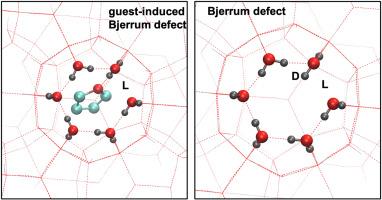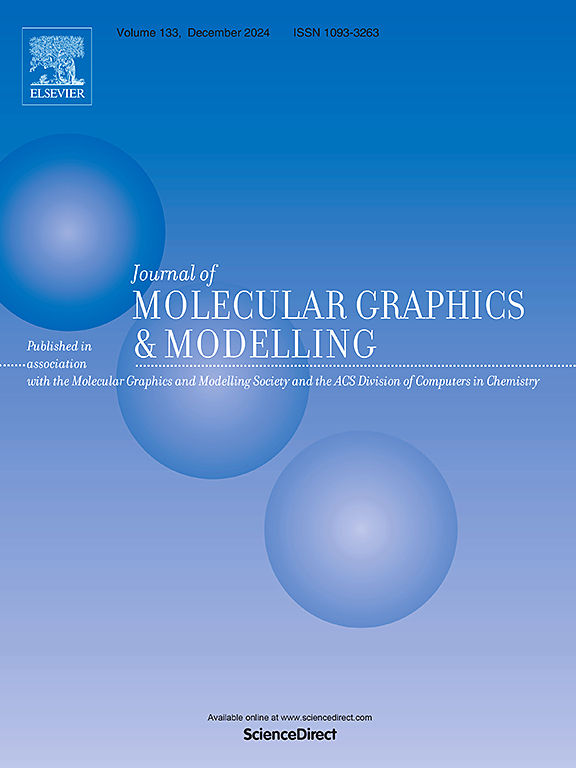s-II 气体水合物中的 Bjerrum 缺陷。
IF 2.7
4区 生物学
Q2 BIOCHEMICAL RESEARCH METHODS
引用次数: 0
摘要
通过对有限尺寸簇和周期性三维晶格系统进行第一性原理计算,研究了结构 II 气体水合物中 Bjerrum 缺陷的能量和结构。首次计算了当结构 II 的笼子完全为空且大笼子中充满一个 THF 分子时这些缺陷的形成能量。与冰结构中的发现类似,形成 D 缺陷的一个氢原子被注意到朝向笼。如果多余的质子位于大笼子中,它就会成为极性客体分子(即 THF)的吸引中心。因此,大笼客体 THF 分子通过与 D 缺陷形成氢键,稳定了 D/L 缺陷对并隔离了 D/L 缺陷形成能量。在这种情况下,代表含有与 D 缺陷的一个氢原子相互作用的 THF 分子的 D/L 缺陷对的缺陷结构反映了客体诱导的缺陷结构。值得注意的是,经典的 Bjerrum 缺陷和客体诱导的 Bjerrum 缺陷在缺陷结构中表现出类似的现象。与现有文献相反,客人诱导的 Bjerrum 缺陷显然涉及 L 和 D 两部分。从这项研究中获得的见解有可能为理解各种实验观察结果(如与介电和核磁共振特性相关的观察结果)提供另一种视角。本文章由计算机程序翻译,如有差异,请以英文原文为准。

Bjerrum defects in s-II gas hydrate
The energy and structure of Bjerrum defects in structure II gas hydrates were investigated by using first-principle calculations for finite-size clusters and periodic 3D lattice systems. The formation energies of these defects were calculated for the first time when the cages of the structure II structure were completely empty and the large cage was filled with a THF molecule. Analogous to findings in ice structures, one of the hydrogen atoms forming the D defect was noted to orient toward the cage. If the excess proton resides in the large cage, it acts as an attraction center for the polar guest molecule, i.e., THF. Therefore, the large cage guest THF molecule stabilizes the D/L defect pair and isolated D/L defect formation energies by forming hydrogen bonds with the D defect. In such cases, the defect structure representing a D/L defect pair containing a THF molecule interacting with one of the hydrogen atoms of the D defect mirrors the guest-induced ones. Notably, the classical Bjerrum defect and the guest-induced Bjerrum defect exhibit a similar phenomenon in defective structures. Contrary to existing literature, it is evident that guest-induced Bjerrum defects involve both the L and D components. The insights gained from this study could potentially offer an alternative perspective to understand various experimental observations, such as those related to dielectric and NMR properties.
求助全文
通过发布文献求助,成功后即可免费获取论文全文。
去求助
来源期刊

Journal of molecular graphics & modelling
生物-计算机:跨学科应用
CiteScore
5.50
自引率
6.90%
发文量
216
审稿时长
35 days
期刊介绍:
The Journal of Molecular Graphics and Modelling is devoted to the publication of papers on the uses of computers in theoretical investigations of molecular structure, function, interaction, and design. The scope of the journal includes all aspects of molecular modeling and computational chemistry, including, for instance, the study of molecular shape and properties, molecular simulations, protein and polymer engineering, drug design, materials design, structure-activity and structure-property relationships, database mining, and compound library design.
As a primary research journal, JMGM seeks to bring new knowledge to the attention of our readers. As such, submissions to the journal need to not only report results, but must draw conclusions and explore implications of the work presented. Authors are strongly encouraged to bear this in mind when preparing manuscripts. Routine applications of standard modelling approaches, providing only very limited new scientific insight, will not meet our criteria for publication. Reproducibility of reported calculations is an important issue. Wherever possible, we urge authors to enhance their papers with Supplementary Data, for example, in QSAR studies machine-readable versions of molecular datasets or in the development of new force-field parameters versions of the topology and force field parameter files. Routine applications of existing methods that do not lead to genuinely new insight will not be considered.
 求助内容:
求助内容: 应助结果提醒方式:
应助结果提醒方式:


